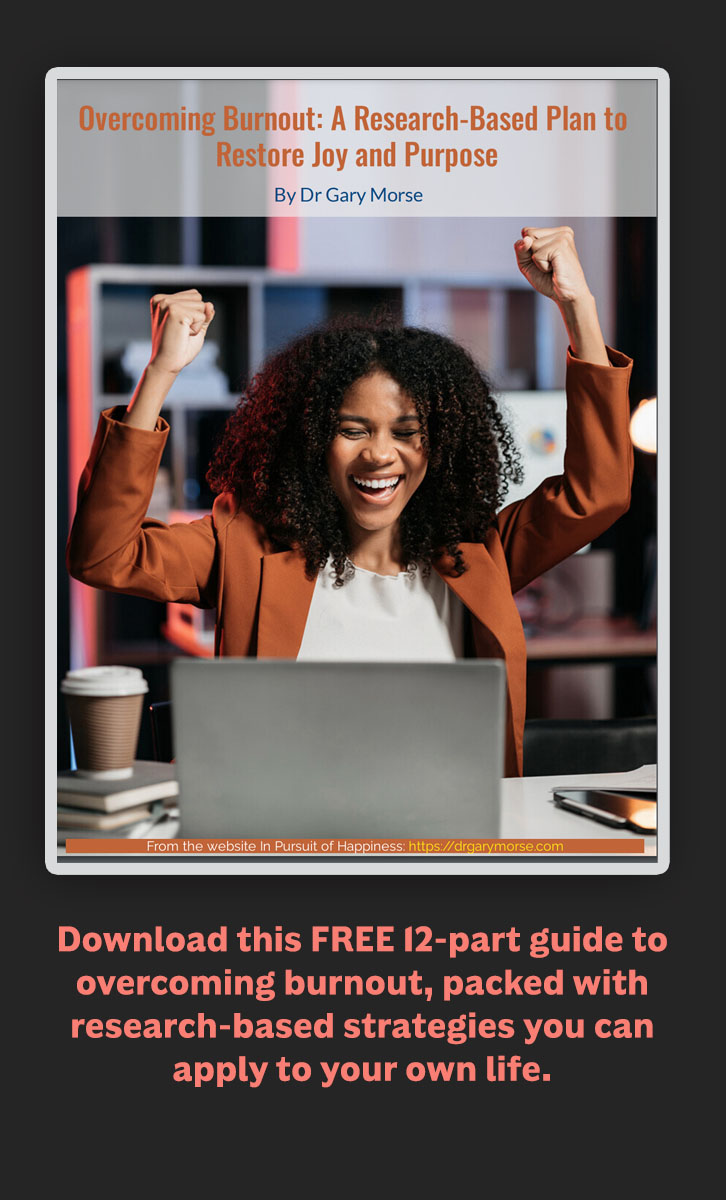Learn how to effectively handle work conflicts to improve your well-being in this ninth post in the Overcoming Burnout Series
Social relationships are powerful factors affecting our health, happiness, and well-being. And social support buffers stress and reduces burnout. A wealth of research supports these statements, and they are also backed up by the personal experiences of millions of people—including probably your own! Think of some of your happiest times. Don’t some of your most joyful experiences involve other people? Further, can you think of a time when you were feeling stressed, upset, or sad and when the kind words (or even company) of a friend, family member, or coworker took the sting away from the troubling emotions? And what about the flip side of the emotional impact of other people? When you feel upset, angry, disappointed—don’t these troubling emotions also often involve other people? In short, other people, including those at work, have a major impact on how we feel about ourselves, our day, and our work.

Photo by Amy Hirschi on Unsplash
This can be a positive or a negative experience—but all too often, the people we work with are more of a strain than a boost to our well-being. A study of working women asked them to rate the level of happiness they felt when they were with different groups of people, including friends, family, coworkers, customers, and bosses. Respondents reported they felt the greatest happiness with friends, followed by family. Spending time with customers and coworkers received low to medium ratings of happiness. Meanwhile, the lowest rating was reserved for time with bosses. Unless we change jobs, we can’t change the people we work with. But fortunately, we can take actions to increase our social support and build more positive relationships with the people with whom we do work. One of the most important areas to focus on is learning to positively resolve conflicts at work,
Dysfunctional Workplace Conflict Dynamics
Conflicts are inevitable in relationships, even generally positive ones. And conflicts arise at work all the time. Although conflicts are common, and even normal, how we handle them make all the difference in our relationships and our levels of stress and well-being. Relationships can continue to be okay—and even grow and deepen—if conflicts are handled well. On the other hand, conflicts, when not handled effectively, can destroy work relationships, poison business environments, and trigger severe burnout. People often respond to interpersonal conflicts at work (and other situations) in one of three ways: (1.) Avoidance, which can allow the problem and negative feelings to fester, while undermining healthy work relationships. (2.) Aggressive responses, such as getting angry, blaming the other, trying to control or even bully the coworker. Of course, aggressive responses do not effectively resolve problems, nor are they good for relationships or the emotional life of either party involved. (3.) Ineffective communication. Edmondson and Smith (2006) noted conflicts often initiate around differences concerning work tasks, with two (or more) coworkers holding differing perspectives on the project or problem and how to address it. Each person not only initially presents his own view, but then continues to repeat the same points, over and over again, in a futile attempt to convince the other person of his opinion. Each side is invested in its own thinking about the situation—and these positions tend to get stronger and less flexible in the ensuing discussion as the other person also argues her points.

Graphic by Gerd Altmann on Pixabay
Edmondson and Smith noted that when this process of entrenchment occurs, the problem-solving discussion reaches an impasse, which then triggers each side to form negative attributions about the other person’s motives, traits, or abilities. For example, and perhaps you have witnessed this in your own work situations, when the discussion gets stuck, it is easy to think about the other in negative terms, such as he is “just stubborn” or “doesn’t know what he is talking about” or “she’s just controlling and bossy,” or “it’s a power grab.” There are no shortage of negative attributions that arise when discussions get stuck and conflicts remain unresolved. Unfortunately, when this happens, each side tends to experience more troubling emotions—such as stress, frustration, anger—and the conflict continues to escalate while progress toward a satisfactory resolution evaporates.

Graphic by Gerd Altmann on Pixabay
Overtime, these ineffective conflict resolution patterns damage team morale, diminish the engagement of workers in their job, and spawn burnout. Like it or not, relationship conflicts are part of life, including work life. While a degree of relationship conflicts will always occur, they are exacerbated or positively resolved by our knowledge, skills, and behaviors. We may not be able to control the behaviors of others, but we can develop the knowledge and skills to deal effectively with work conflicts that help to satisfactorily resolve problems and maintain our own well-being.
Effectively Handling Conflict: Mindful and Open Dialogue
I have found a seven-step strategy useful for successfully resolving many work conflicts. This approach is grounded in mindful awareness, openness, empathy—and assertiveness when needed. It also builds on ideas from both Edmondson and Smith’s work on workplace conflicts and also Fisher and Ury’s classic approach described in Getting to Yes: Negotiating Agreement Without Giving In. This approach helps us to engage in “courageous conversations,” to borrow a phrase from David Whyte, rather than to avoid difficult issues that can undermine both the relationships and our own well-being. Here are the seven steps to mindful and open dialogue:
(1.) Mindful observance that conflict is mounting.
Be aware of the social—and your individual—cues and observe the early warning signs indicating that a conflict is developing. These signs vary by the person but often include raised and tensed voices, interrupting each other, and perhaps sensing an inner flight-or-fight response.
(2.) Relax.
It is helpful to allow yourself to relax when a conflict is beginning to develop between you and another. Taking a few, slower, conscious breaths can often dissipate tension and leave you feeling more relaxed.

By Deurk Makara on Pixabay
(3.) Center on your values.
Take a moment to silently remind yourself of your core values. How do you want to be toward other people? Does it include understanding, compassion, and kindness? If so, remind yourself and then try to center your response in your values as well as the details of the conflict.
(4.) Be open and inquiring.
Often when communication breaks down and conflict escalates, we have stopped listening to the other person. Instead, we are thinking more about our next response and how we can win the argument, which exacerbates the impasse and tensions. You can break this cycle and de-escalate the conflict by taking a more open and inquiring approach. One way to do this is to gently ask open-ended questions to truly try to understand the other person’s point of view (rather than trying to see any weaknesses in their argument that you can then attack). Also, try to understand why the position is important to the other person. What underlying interests or values are at the root of their position? And do any of those interests or values match yours, revealing possible common ground? Also, this is a good time to examine your own motives. Is the issue truly an important one for your work that needs your advocacy? Often, this is the case, but if we are honest with ourselves, sometimes we lock into conflicts for motives that do not reflect our best selves, such as simply wanting to win an argument or to appear powerful or be dominant. If this is the case, consider what is best for your work and what aligns most closely with your highest values—not your ego.

Photo credit: LinkedIn Sales Solutions, Unsplash.com
(5) Adopt a “Teflon” response.
Ronald Reagan was said to be a master of the “Teflon Approach”—of letting snarky, angry, or critical remarks slide off without taking it personally. It is not uncommon for people to make critical or snarky remarks in the middle of heated work debates. Reacting to such comments personally, which is the gut response for many of us, only heightens the emotional and personal nature of a conflict and further derails a positive resolution to the conflict. Instead can you try to put on a Teflon defense (you can even try using imagery—e.g., imagine yourself putting up a Teflon shield) and let the negative reaction from the other person slide away without getting caught in an emotional response? Doing so helps you to be the bigger the person—and it can help the other person to settle emotionally (or to look immature to others if they continue to react emotionally).
(6) Express understanding and empathy.
When embroiled in a work argument, we often feel the other person doesn’t understand us (hence the tendency to continue to make our same points, over and over). Just as you may feel you are not being understood, probably so too does the other person. You can often deescalate a conflict and move toward a positive resolution by acknowledging or empathizing with the other person’s interests, situation, or feelings. Taking such an approach can help the other person to feel like you understand, thereby releasing them from the need to continue a relentless cycle of repeating the same points over and over. You can even go a step beyond typical empathy and remind yourself about the other person’s good qualities and behaviors, even if they aren’t apparent in the heat of the moment. Holding that knowledge in your own mind helps you continue the conversation in a kind and positive way—an approach that is likely to lead to a better resolution of the conflict.
(7) Choose a compassionate and effective response.
Sometimes we become so embroiled in the conflict that we react out of our emotions instead of our wisdom. Reacting emotionally—out of frustration, anger, hurt and more—is an understandable initial reaction to conflict, but usually it is not the most effective response. By using the preceding six steps, you are likely to reach a better understanding of the other person and the problem, to identify common ground, and to feel more empathy. With a better understanding, you may be able to generate creative solutions or identify “third possibilities” that bridge some of the other person’s core interests and your own while resolving the conflict.

Photo by David Trinks on Unsplash
Or, in some situations, you may believe you still need to advance your plan or position without accommodating the other person’s wishes. You may need to do so while assertively stating your opinion or plan. In these cases, can you do so respectfully and compassionately as well as assertively? Doing so can help to maintain—rather than destroy—positive working relationships beyond the conflicted issue at hand. This seven-step approach for resolving conflicts won’t necessarily work every time. But it will be helpful in many situations and help to maintain positive relationships at work.
Additional Strategies
The seven-step approach is not the only way to resolve workplace conflicts. Even before a situation becomes conflictual in discussions, it can be useful to do a self-check on your own thinking. As described in a prior post on using cognitive-behavioral thinking at it relates to burnout, we can sometimes misinterpret situations in a negative and personal way. Examining your own thoughts and the evidence of the situation, as described, can sometimes prevent a situation from degenerating into a conflict with you and a coworker or boss.

Credit: House of Legacy from Pixaby
Another, simple and interpersonal strategy is to try building a relationship with the person with whom you are having conflicts. The premise is simple, as my colleague Dr. Michelle Salyers once shared via an Abraham Lincoln quote: “I don’t like that man. I must get to know him better.” If it worked for one of the greatest Presidents of the United States, it just might work for you, too. You can, for example, try spending more time with the person, but in low-stakes, easy encounters, such as stopping and chatting in the hallway or asking the person to get together for coffee. Getting to know the individual better and looking for the positives and strengths in the other person can help counterbalance whatever negative opinions you may have developed. Taking this approach can dissipate some of the tension that developed from past conflicts and which might otherwise fuel new conflicts. To your surprise, you might even discover that as a result of your efforts, you’ve developed a new work ally or friend. In addition to these three approaches for reducing work conflicts (getting to know the person better, using realistic and positive cognitive skills, and mindful and open dialogue), there are additional strategies for increasing positive social relationships and social support at work As described, in the upcoming book, Finding Purpose in a Burned Out World: How You Can Overcome Burnout. BREATHE helps you to learn and use four additional major strategies for improving your social relationships and support and reducing burnout:
- Connect with positive people
- Ask for support
- Practice good social skills
- No matter what, keep your sanity and stay healthy.
In short, there are plenty of ways for you to improve your social connections at work. Doing so is likely to help you feel better about your job and better emotionally, with less burnout. Don’t you deserve giving that a try?
Lead photo by Yan Krukau on Pexels



Follow Me: